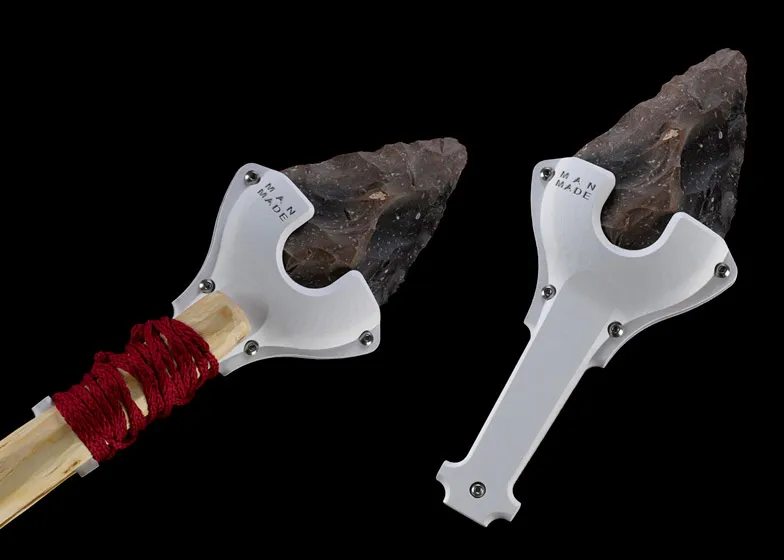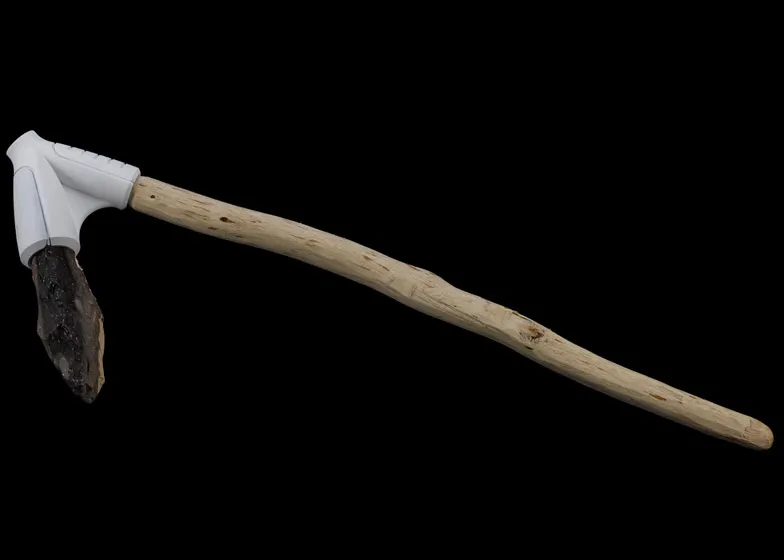Designers Remake Our Oldest Tool Using Our Newest Tool
More than a million years old, the hand axe is over due for an update
/https://tf-cmsv2-smithsonianmag-media.s3.amazonaws.com/filer/c8/cc/c8cc51b5-3ab8-4ffb-8493-a33eeb3e62b5/man-made-adinov-1.jpg)
The hand axe is the first tool. Ever. Contrary to the opening sequence of 2001: A Space Odyssey, this tool isn't a bone, but a pointy rock - which is pretty impressive when you consider that it dates back at least 1.5 million years. Typically made of a flint stone, rounded on one side, pointed on the other, with sharp edges in between, the hand axe was an all-purpose utility tool used for hunting, digging, chopping and whatever other tasks early hominids could dream up. Today, we can dream up a lot more. But it seems like our dreams are outpaced by our technology, which has advanced quite a few steps over the last million years and seems to do so more rapidly ever decade. We now have more tools than we know how to use productively but that hasn't stopped a pair of designers from using today's cutting-edge tools to update the preferred cutting edge of the early Pleistocene.

Man Made is a project from Tel-Aviv based designers Ami Drach and Dov Ganchrow, who have combined the oldest tool-weapon with computer scanning and 3D printing to create a sort of hand-axe 2.0. New and improved, it has nine different add-ons that each optimize the stone for a specific use. What was once a general tool becomes specialized. The attachments transform the hand axe into spear, an axe or adze, a throwing weapon, a knife, a hammer, or a trowel. But these handles aren't just created for specific tasks, they're bespoke designs fitted to specific flint stones, which the designers also made by painstakingly--with a focus on pain--sculpting the stones in a messy, bloody process involving "striking the flint with a softer stone to create controlled breakages, and chipping away flint flakes as the impact's shock wave runs through the stone." The results, looking appropriately ancient, were then 3D scanned to ensure the printed components were a precise fit.

The project is an evolution of their series, bc-ad, which explored modernizing stone tools with other methods including dipped latex and silver plating.

These composite tools are striking and provocative. There's something incredibly pleasing about the aesthetic and conceptual juxtaposition of the roughly hewn stone and the streamlined, technologically produced handles. Yet, I feel like there's some sinister undertone in the union of ancient and modern products/processes that keeps bringing me back to the "Dawn of Man" sequence that opens 2001.
In the beginning of the film, an ape picks up a bone and uses it to smash an animal skull, and then to defeat the leader of another tribe, thereby discovering the first tool/weapon (which for some reason is not included in the above clip). Then, our primitive ancestor throws the bone in the air and Kubrick famously match cuts to a nuclear-armed satellite (identified as such in early drafts of the script but never mentioned in the final film), orbiting Earth 4 million years into the future. A seamless cut from the first tool to the last. No matter how advanced our technology becomes, we are wont to put it toward destructive ends. While 3D printing is certainly not on the same scale as a nuclear threat, it does have the power to be used for good and ill, as we have already seen: various types of printers are being used to print everything from toys to houses to food to guns. When I look at these ultra-retro-future tools of the Man Made project, I can't help but think of a post-apocalyptic scenario when the last vestiges of our technology are used to create the tools and weapons we need to survive, a physical manifestation of Albert Einstein's famous quote: "I do not know how the Third World War will be fought, but I can tell you what they will use in the Fourth -- rocks"
AT THE SMITHSONIAN
The exhibit Tools: Extending our Reach, will be a featured exhibit when the newly-renovated Cooper–Hewitt, Smithsonian Design Museum, reopens on December 12, 2014, and will showcase objects from across the Smithsonian's collections.
/https://tf-cmsv2-smithsonianmag-media.s3.amazonaws.com/accounts/headshot/Jimmy-Stamp-240.jpg)


/https://tf-cmsv2-smithsonianmag-media.s3.amazonaws.com/accounts/headshot/Jimmy-Stamp-240.jpg)